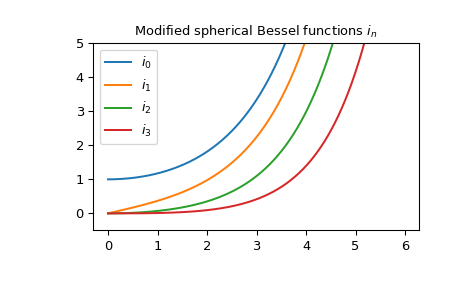scipy.special.spherical_in#
- scipy.special.spherical_in(n, z, derivative=False)[source]#
Modified spherical Bessel function of the first kind or its derivative.
Defined as [1],
\[i_n(z) = \sqrt{\frac{\pi}{2z}} I_{n + 1/2}(z),\]where \(I_n\) is the modified Bessel function of the first kind.
- Parameters:
- nint, array_like
Order of the Bessel function (n >= 0).
- zcomplex or float, array_like
Argument of the Bessel function.
- derivativebool, optional
If True, the value of the derivative (rather than the function itself) is returned.
- Returns:
- inndarray
Notes
The function is computed using its definitional relation to the modified cylindrical Bessel function of the first kind.
The derivative is computed using the relations [2],
\[ \begin{align}\begin{aligned}i_n' = i_{n-1} - \frac{n + 1}{z} i_n.\\i_1' = i_0\end{aligned}\end{align} \]New in version 0.18.0.
References
[AS]Milton Abramowitz and Irene A. Stegun, eds. Handbook of Mathematical Functions with Formulas, Graphs, and Mathematical Tables. New York: Dover, 1972.
Examples
The modified spherical Bessel functions of the first kind \(i_n\) accept both real and complex second argument. They can return a complex type:
>>> from scipy.special import spherical_in >>> spherical_in(0, 3+5j) (-1.1689867793369182-1.2697305267234222j) >>> type(spherical_in(0, 3+5j)) <class 'numpy.complex128'>
We can verify the relation for the derivative from the Notes for \(n=3\) in the interval \([1, 2]\):
>>> import numpy as np >>> x = np.arange(1.0, 2.0, 0.01) >>> np.allclose(spherical_in(3, x, True), ... spherical_in(2, x) - 4/x * spherical_in(3, x)) True
The first few \(i_n\) with real argument:
>>> import matplotlib.pyplot as plt >>> x = np.arange(0.0, 6.0, 0.01) >>> fig, ax = plt.subplots() >>> ax.set_ylim(-0.5, 5.0) >>> ax.set_title(r'Modified spherical Bessel functions $i_n$') >>> for n in np.arange(0, 4): ... ax.plot(x, spherical_in(n, x), label=rf'$i_{n}$') >>> plt.legend(loc='best') >>> plt.show()
